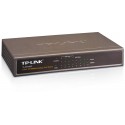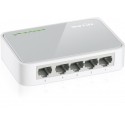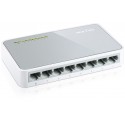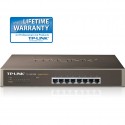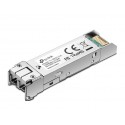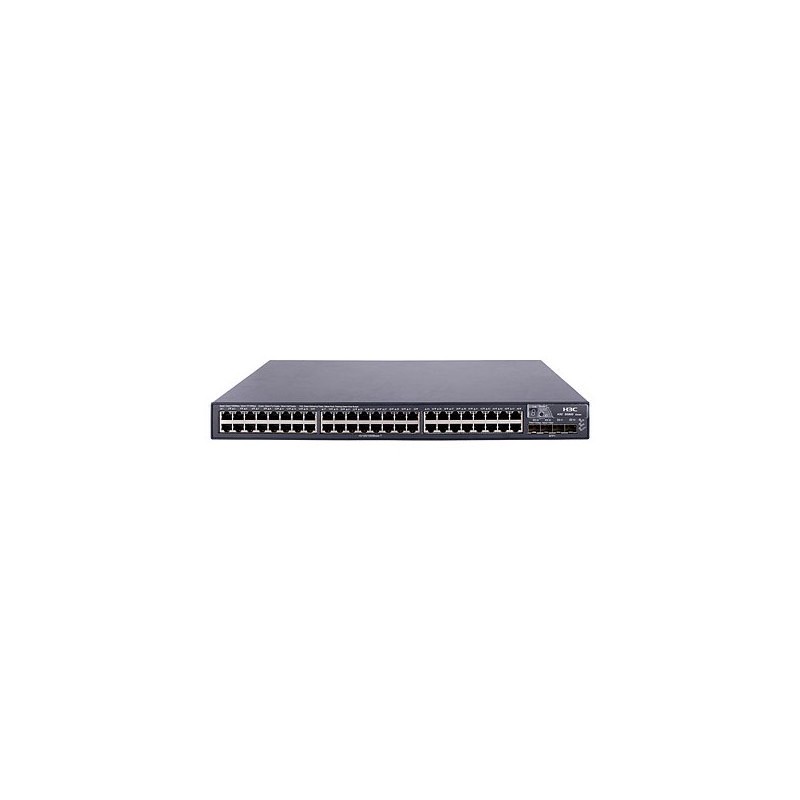
HP 5800 series switches offer an unmatched combination of Gigabit and 10-Gigabit Ethernet port density, high-availability architecture, and full Layer 2 and Layer 3 dual-stack IPv4 and IPv6 capabilities. In addition to wire-speed line-rate performance on all ports, the switches include patented Intelligent Resilient Framework (IRF) technology and Rapid Ring Protection Protocol (RRPP), which allow local or geographically distributed HP 5800 switches to be interconnected for higher resiliency and performance. Available in PoE and non-PoE models as well as 1 RU and 2 RU flex chassis configurations, HP 5800 switches are built on open standards and include an open application architecture (OAA) module slot that enables flexible deployment options for new services. These versatile switches are ideal for use in the network core of buildings or departments, or as high-performance switches in the convergence layer or network edge of enterprise campus networks.
- Powerful QoS feature: creates traffic classes based on access control lists (ACLs), IEEE 802.1p precedence, IP, and DSCP or Type of Service (ToS) precedence; supports filter, redirect, mirror, or remark; supports the following congestion actions: strict priority (SP) queuing, weighted round robin (WRR), weighted fair queuing (WFQ), weighted random early discard (WRED), weighted deficit round robin (WDRR), and SP+WDRR. Integrated network services: with support for open application architecture (OAA) modules, extends and integrates application capability into the network. Ring Resiliency Protection Protocol (RRPP): provides fast recovery for ring Ethernet-based topology; provides consistent application performance for applications such as VoIP.
- Remote configuration and management: is available through a secure Web browser or a command-line interface (CLI). IEEE 802.1ab LLDP discovery: advertises and receives management information from adjacent devices on a network. USB support: File copy: allows users to copy switch files to and from a USB flash drive . DHCP options: - DNS Relay and SMTP Redirection. - DHCP: Server (RFC 2131), Client, and Option-82 Relay (RFC 3046). sFlow: provides scalable, ASIC-based networkmonitoring and accounting; this allows network operators to gather a variety of sophisticated network statistics and information for capacity planning and real-time network monitoring purposes.
- High-density port connectivity: supports up to 84 1-Gigabit ports per unit/612 per stack. Auto-MDIX: automatically adjusts for straight-through or crossover cables on all 10/100 ports. Jumbo frames: on Gigabit Ethernet and 10-Gigabit ports, have maximum frame length of 9K; allow high-performance remote backup and disaster-recovery services. IEEE 802.3af Power over Ethernet (PoE): provides up to 15.4 W per port to IEEE 802.3af-compliant PoE-powered devices such as IP phones, wireless access points, and security cameras. IEEE 802.3at Power over Ethernet (PoE+): provide up to 30 W per port that allows support of the latest PoE+-capable devices such as IP phones, wireless access points, and security cameras, as well as any IEEE 802.3af-compliant end device; eliminates the cost for additional electrical cabling and circuits that would otherwise be necessary in IP phone and WLAN deployments.
- Hardware-based wire-speed access control lists (ACLs): feature-rich ACL implementation (TCAM-based) helps ensure high levels of security and ease of administration without impacting network performance. Unique Flex-Chassis Architecture: supports the best of both fixed chassis and modular configurations.
- Data center–optimized design: HP 5800AF-48G Switch (JG225A) supports front-to-back/back-to-front airflow for hot/cold aisles, rear rack mounts, and redundant hot-swappable AC or DC power and fans.
- Full-featured console: provides complete control of the switch with a familiar command-line interface (CLI). Web interface: allows configuration of the switch from any Web browser on the network. RMON and sFlow: provide advanced monitoring and reporting capabilities for statistics, history, alarms, and events. Multiple configuration files: allow multiple configuration files to be stored to a flash image. Troubleshooting: Ingress and egress port monitoring: enable network problem solving. Tracert and Ping: enable testing of network connectivity. Virtual Cable Tests: provide visibility to cable problems.
- Powerful QoS feature: creates traffic classes based on access control lists (ACLs), IEEE 802.1p precedence, IP, and DSCP or Type of Service (ToS) precedence; supports filter, redirect, mirror, or remark; supports the following congestion actions: strict priority (SP) queuing, weighted round robin (WRR), weighted fair queuing (WFQ), weighted random early discard (WRED), weighted deficit round robin (WDRR), and SP+WDRR. Integrated network services: with support for open application architecture (OAA) modules, extends and integrates application capability into the network. Ring Resiliency Protection Protocol (RRPP): provides fast recovery for ring Ethernet-based topology; provides consistent application performance for applications such as VoIP.
- Remote configuration and management: is available through a secure Web browser or a command-line interface (CLI). IEEE 802.1ab LLDP discovery: advertises and receives management information from adjacent devices on a network. USB support: File copy: allows users to copy switch files to and from a USB flash drive . DHCP options: - DNS Relay and SMTP Redirection. - DHCP: Server (RFC 2131), Client, and Option-82 Relay (RFC 3046). sFlow: provides scalable, ASIC-based networkmonitoring and accounting; this allows network operators to gather a variety of sophisticated network statistics and information for capacity planning and real-time network monitoring purposes.
- High-density port connectivity: supports up to 84 1-Gigabit ports per unit/612 per stack. Auto-MDIX: automatically adjusts for straight-through or crossover cables on all 10/100 ports. Jumbo frames: on Gigabit Ethernet and 10-Gigabit ports, have maximum frame length of 9K; allow high-performance remote backup and disaster-recovery services. IEEE 802.3af Power over Ethernet (PoE): provides up to 15.4 W per port to IEEE 802.3af-compliant PoE-powered devices such as IP phones, wireless access points, and security cameras. IEEE 802.3at Power over Ethernet (PoE+): provide up to 30 W per port that allows support of the latest PoE+-capable devices such as IP phones, wireless access points, and security cameras, as well as any IEEE 802.3af-compliant end device; eliminates the cost for additional electrical cabling and circuits that would otherwise be necessary in IP phone and WLAN deployments.
- Hardware-based wire-speed access control lists (ACLs): feature-rich ACL implementation (TCAM-based) helps ensure high levels of security and ease of administration without impacting network performance. Unique Flex-Chassis Architecture: supports the best of both fixed chassis and modular configurations.
- Data center–optimized design: HP 5800AF-48G Switch (JG225A) supports front-to-back/back-to-front airflow for hot/cold aisles, rear rack mounts, and redundant hot-swappable AC or DC power and fans.
- Full-featured console: provides complete control of the switch with a familiar command-line interface (CLI). Web interface: allows configuration of the switch from any Web browser on the network. RMON and sFlow: provide advanced monitoring and reporting capabilities for statistics, history, alarms, and events. Multiple configuration files: allow multiple configuration files to be stored to a flash image. Troubleshooting: Ingress and egress port monitoring: enable network problem solving. Tracert and Ping: enable testing of network connectivity. Virtual Cable Tests: provide visibility to cable problems.
| AC input frequency | 50/60 Hz |
| AC input voltage | 100-240 V |
| Basic switching RJ-45 Ethernet ports quantity | 48 |
| Certification | RoHS |
| Colour of product | Black |
| Connectivity technology | Wired |
| Copper ethernet cabling technology | 1000BASE-T,100BASE-T,100BASE-TX,10BASE-T |
| DC-in jack | Yes |
| Depth | 427 mm |
| Dimensions (W x D x H) | 427 x 439.9 x 43.7 mm (16.81 x 17.32 x 1.72 ") |
| Dimensions (WxDxH) | 427 x 440 x 43.6 mm |
| Electromagnetic compatibility | VCCI; EN 55022; ICES-003; ANSI C63.4 2003; AS/NZS CISPR22; EN 61000-3-2:2006; EN 61000-3-3:1995 +A1:2001+A2:2005; EMC Directive 2004/108/EC; FCC |
| Ethernet interface type | Gigabit Ethernet |
| Ethernet LAN | Yes |
| Ethernet LAN (RJ-45) ports quantity | 48 |
| Ethernet LAN data rates | 10,100,1000 Mbit/s |
| Expansion slots | (1 Total) Expansion Slot, (4 Total) SFP+ |
| Flash memory | 512 MB |
| Flow control support | Yes |
| Form factor | 1U |
| Full duplex | Yes |
| Heat dissipation | 3320 BTU/h |
| Height | 43 mm |
| Input frequency | 50 / 60 Hz |
| Input voltage | 100 - 240 V |
| Internal memory | 512 MB |
| Latency | 4.02 |
| LED indicators | Yes |
| MAC address table | 32000 entries |
| Management platform | IMC; Web browser; SNMP; Telnet; HTTPS; RMON1; FTP |
| Management protocols | QoS, VLAN, SNMP v1/v2c/v3, Telnet, RMON 1, 2, 3, 9, sFlow |
| Maximum data transfer rate | 1 Gbit/s |
| Memory type | SDRAM |
| Networking features | Gigabit Ethernet |
| Networking standards | IEEE 802.3,IEEE 802.3ad,IEEE 802.3u |
| Number of VLANs | 4094 |
| Operating relative humidity (H-H) | 10 - 90 % |
| Operating relative humidity range | 10 - 90 % |
| Operating temperature range (T-T) | 0 - 45 °C |
| Packet buffer memory | 512 MB |
| Power over Ethernet (PoE) | Yes |
| Power over Ethernet (PoE) support | Yes |
| Quality of Service (QoS) support | Yes |
| Rack mounting | Yes |
| Safety | UL 60950-1; EN 60825-1; EN 60825-2; IEC 60950-1; CAN/CSA-C22.2 No. 60950-1; ULAR; GOST; EN 60950-1/A11; FDA 21 CFR; NOM |
| Source data-sheet | Icecat.biz |
| Supported data transfer rates | 10/100/1000 Mbps |
| Switch layer | L3 |
| Switching capacity | 256 Gbit/s |
| Throughput | 190 mpps |
| User guide | Yes |
| Web-based management | Yes |
| Weight | 8500 g |
| Width | 439 mm |
| Wireless LAN connection | No |



